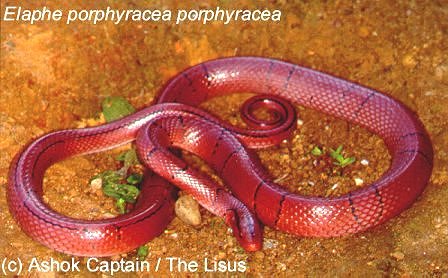 |










(Click on small pictures to view larger version)
| Scientific Name: | Elaphe porphyracea (Cantor, 1839) |
| Common Names: | Red Mountain Ratsnake, Bamboo Ratsnake, Broad-banded Mountain Ratsnake, Black-banded Trinket Snake |
| Subspecies: |
Elaphe porphyracea porphyracea (Cantor, 1839) Elaphe porphyracea coxi (Schulz & Helfenberger, 1998) Elaphe porphyracea kawakamii (Oshima, 1911) Elaphe porphyracea laticincta (Schulz & Helfenberger, 1998) Elaphe porphyracea nigrofasciata (Cantor, 1839) Elaphe porphyracea pulchra (Schmidt, 1925) Elaphe porphyracea vaillanti (Sauvage, 1876) |
| Size: | 80 to 90 cm (up to 120 cm) |
| Distribution: |
E. p. porphyracea: India; Darjeeling and Assam region; Northern Burma; Northwestern Thailand; China, far western Yunnan province and southeastern Tibet E. p. coxi: Northeast Thailand, Loei and Phuluang provinces. E. p. kawakamii: the island of Taiwan E. p. laticincta: Peninsula Malaysia and the island of Sumatra E. p. nigrofasciata: Only the type specimen exists and its exact point of origin is unknown. E. p. pulchra: Central China including the provinces of Sichuan, Shaanxi, Gansu, Guizhou, and Yunnan E. p. vaillanti: Eastern China including Anhui, Fujian, Guangdong, Guangxi, Guizhou, Hunan, Jiangsu, jiangxi, Zhejiang provinces and the island of Hainan; Northern Vietnam
|
| Other Info: |
Elaphe porphyracea is a small ratsnake for the advanced keeper. Mostly wild caught specimens have recently become available and we've seen and heard of a lot of problems with keeping them alive. A few captive bred babies have also recently become available and seem to provide no problems. In the wild, E. porphyracea inhabits a wide range of habitats from montane forests to grassy plains with rock and bamboo. They are a very secretive snake, terrestrial and spend most of their time burrowing under mats of moss, grass, under logs or rocks. They are mainly active in the early morning and late afternoon hours. Provide with a lot of hiding areas and a substrate they can burrow in. The humidity in the enclosure should be kept fairly high. E. porphyracea prefer smaller food items. My specimens will only eat pink mice or very small fuzzy mice. Mating takes place in the spring with 3-6 eggs being laid in June or July, with an incubation period of 49-60 days. Most subspecies need to be hibernated. |
